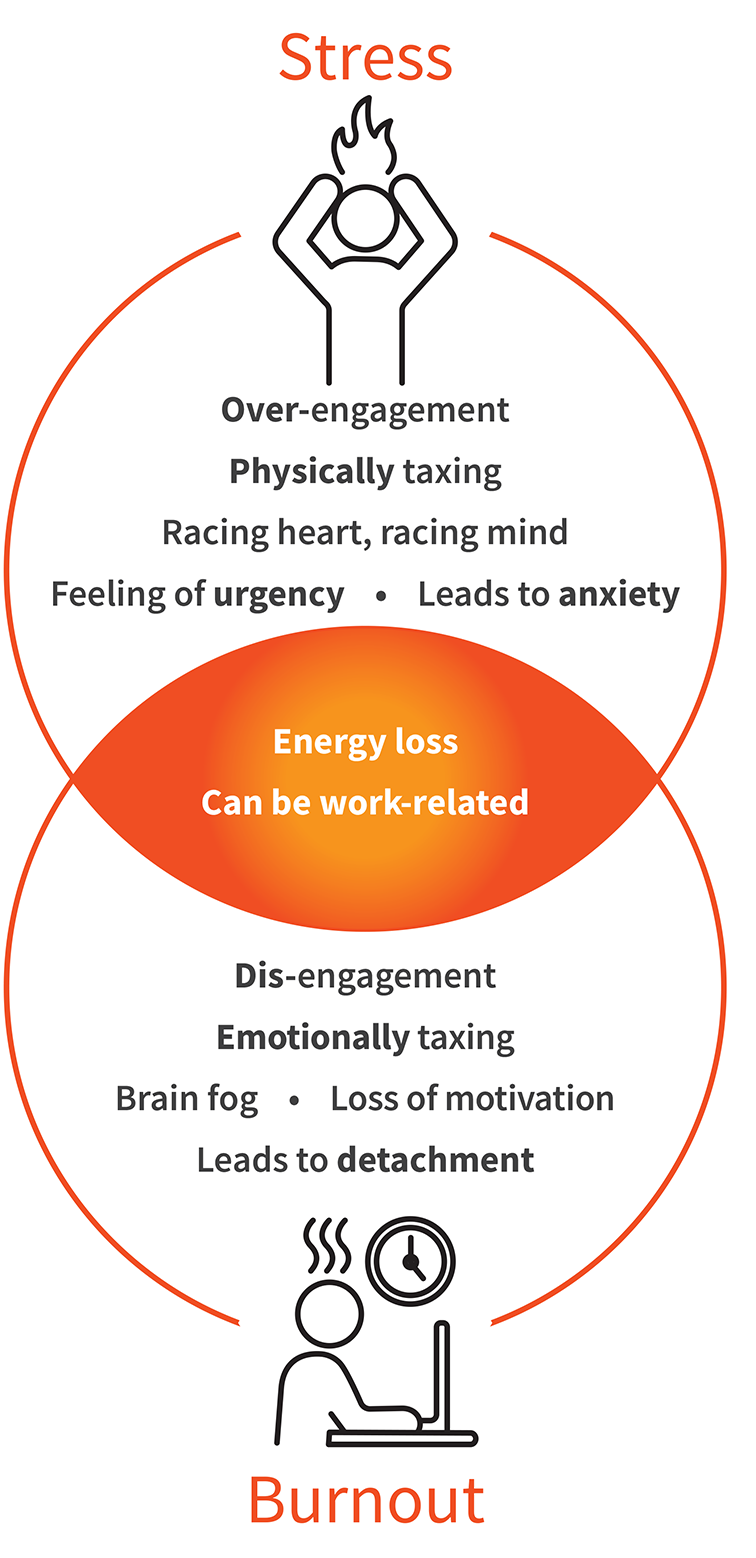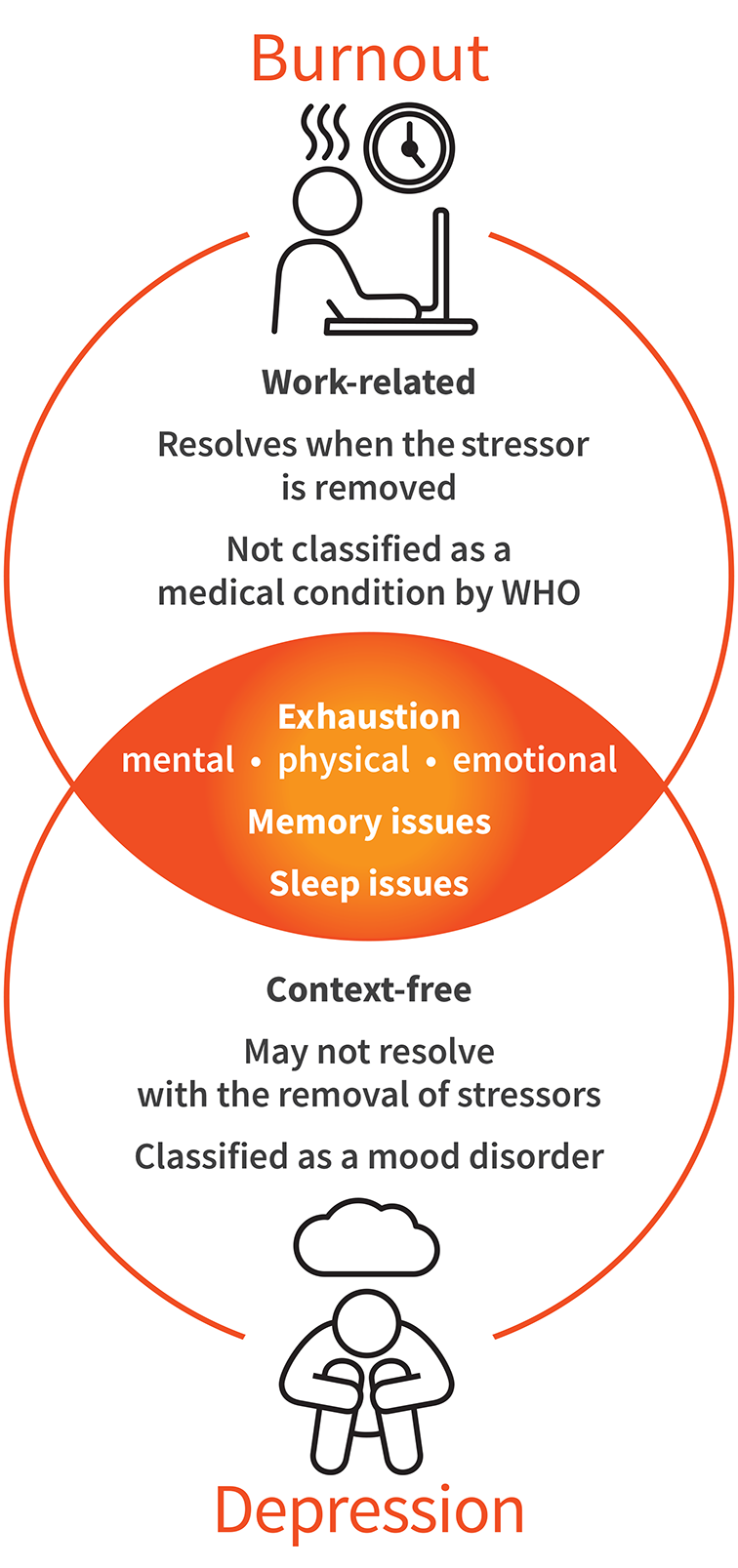Every month our team of Instructional Designers meets for “Talking Teaching” – sessions where we share and discuss interesting articles, methods, and pedagogies. This month, we discussed burnout and especially looked at cases of teacher burnout.
In this blog, I’d like to discuss all things burnout - what it means culturally and medically, when you may experience it, burnout symptoms, and why it may come about.
This blog is the third in our series on well-being. Learn more about developing a pedagogy of care and how to ease student anxiety by incorporating mindfulness into your teaching.
The resource we’d like to share with you this month:
The End of Burnout, with Jonathan Malesic (Episode 395 of the Teaching in Higher Education Podcast). In this podcast, Jonathan Malesic talks about his recently completed book, “The End of Burnout”.
Defining burnout
The term “burnout” is interpreted differently across both the cultural and scientific realms, leading to it being understood in various ways. Some people may believe it is just a form of extreme exhaustion; others understand it as the proverbial wall that you just need to break through to keep going. Ultimately, there isn’t a clear-cut definition for the phenomenon, even among those who study it. However, the increased use of “burnout” in everyday life as a cultural keyword to denote acute stress tends to devalue its medical or scientific meaning as outlined in the 11th revision of the World Health Organization’s International Classifications of Disease (ICD-11).
Breaking down burnout
- Exhaustion: This type of exhaustion does not go away with rest, a break, or a holiday. It is probably most easily recognised of all the dimensions.
- Cynicism: This manifests as depersonalization. A person experiencing burnout may feel far more cynical toward their colleagues, seeing them as problems, rather than people.
- Ineffectiveness: The feeling that you are failing and not achieving.
It is important to note that all three dimensions can be experienced on a spectrum. Experiencing all three does not necessarily mean you are burnt out, nor does it mean that you are not burnt out if you only present with one or two dimensions. Determining how strongly you are experiencing each dimension can be qualified using the Maslac Burnout Inventory (see the MBI-ES subcategory for an inventory specific to educators).
The long road to burnout can be separated into five stages. Developing dimensions can be used to define each stage. One’s experience of each stage is very personal (depending on the stressor, individual history and personal tendencies, life stage, etc.).
Stages of burnout
The stages are as follows:

Burnout is associated with the workplace.
| Burnout stage | Burnout symptoms |
|---|---|
| Honeymoon phase | You are experiencing high job satisfaction and exhibiting lots of energy and commitment. It’s much like the early phases of a relationship: you want to be with them (the job) all the time and when you are not with them, you think fondly of them 24/7. |
| Onset of stress | The “shine” is gone, and pessimism starts creeping in. Acute stress may manifest. Creeping cynicism may lead you to start thinking poorly of your colleagues. |
| Chronic stress | The acute stress now no longer goes away with rest; you may feel “wired” all the time; and the source of your stress (work) becomes a place you want to avoid or escape (escapist mentality). Other behavioral changes may develop, such as withdrawal, denial, etc. |
| Burnout | Feelings of ineffectiveness, exhaustion, and cynicism mean you have no drive to do work. |
| Habitual burnout | The symptoms of burnout are embedded in your life. Symptoms linked to depression (feelings of emptiness, mental and physical exhaustion) become overwhelming, and even start to cause frequent illness. |
The stages will have aspects of each of the dimensions in them. Someone suffering from habitual burnout (the final stage) would score highly in all three dimensions; however, people may be “over-extended” or close to burnout when scoring highly in one or two of the three dimensions.
Common misconceptions about burnout
The relationship between stress and burnout is shown in the following infographic. Stress is usually acute and often linked to a specific task or project. Stress causes your body to go into overdrive.
In comparison, burnout is chronic, unresolved stress where you tend to disengage or detach from your work. And while both can be exhausting, acute stress should fade quickly when the trigger is removed.
Likewise, it is important to know the differences between burnout and depression. The biggest difference is the context. Burnout is conceptualized as resulting from chronic workplace stress that has not been successfully managed. The important word here is workplace. The symptoms of depression - which do crossover with feelings of burnout - do not ease. Recovery from burnout can slowly be achieved by removing the stressor.

Acute stress and burnout differ.

Depression and burnout differ.
With the pandemic sending more people home to work, it would make sense that the line between burnout and depression would blur. With less separation between work life and home life, it is easier for feelings of exhaustion, cynicism, and ineffectiveness to bleed into the home.
Related: Learn 7 practical strategies to support student mental well-being »
Burnout on the rise
An important driver of burnout is the difference between the ideals you bring to a job and the realities of that job. This is something Jonathan Malesic talks about in the podcast, and in his book. With questions like “What do you want to be when you grow up?” and maxims like “Do a job you love and it won’t feel like work.” thrown at us from a young age, much of our identity can become invested in what we do for a living. We let our work define who we are. When that happens, we develop high expectations and ideals (who we want to be and how we want to work) that may not match the realities of our workplaces. This can cause burnout.
Teaching is hard. Pandemic teaching is harder.
Everyone who has worked during the pandemic has likely experienced dimensions found on the burnout spectrum. Specifically, however, there has been a high frequency of teacher burnout.
Even before the pandemic, teachers were twice as likely as other employed adults to experience frequent job-related stress, and almost three times more likely to experience those depressive symptoms of burnout (only matched by other high-stress jobs in the healthcare industry).
Pre-pandemic, one in six teachers were likely to leave their jobs. Now, that statistic has increased to one in four (Steiner & Woo, 2021). This was specifically seen in those teaching learners aged 4 to 12.

Teaching online may not fit with the ideals you have about education.
In higher education, 75% of faculty members reported significant stress as a result of transitioning to new modes of teaching, with 40% saying they would leave their position because of COVID’s impact (Course Hero, 2020).
Switching teaching mode has been a key cause of stress for educators. This switching can also be linked to a disconnect between job-related ideals and new realities. Educators who were prepared for, and perhaps even excited about, face-to-face teaching have had to leave behind that ideal and work using a less familiar and/or comfortable mode of teaching. This would certainly contribute to the onset of burnout. Other stressors for educators include teaching very stressed students, meeting learners’ emotional and mental needs, grappling with technology, and dealing with the impact of COVID on their own lives (Steiner & Woo, 2021).
Related: 3 teaching exercises for mindfulness in the classroom »
Management techniques
As is the case for any mentally taxing and distressing circumstances, taking care of yourself is key. We would suggest all the usual go-tos - mindfulness, exercise, prioritizing rest, and checking in with yourself. However, to step away from those norms, we also suggest doing an exercise where you look at your job-related ideals and see if there are many that aren’t reflected by your reality.
For example, you might be someone that ideally wanted to be working in an office with many people, but the reality is you now work from home by yourself. In this case, there’s a large gap between your ideals and your reality. With this information, perhaps you could talk to your manager or team to work out a way to add more interaction into your day - for example, an extra catch-up tea break via Zoom, or asking some others to come into the office with you on specific days so you have company.
An easy way to help identify your ideals is to work out your key values in life (for example, you value your family, so maybe your ideal is a job with flexible work hours to maximize family time).
Further ideas to help anyone who may feel over-extended:
- Fail fast: If you are stuck or struggling on a project, ask for a fresh pair of eyes. This will allow you some distance and potentially spark some more ideas/excitement for the project.
- Say “No”: If you feel a new task would cause you to be over-extended, say no. A great way of doing this is to ask your manager to help you “re-prioritize” your to-do list to accommodate the new task. Once they hear about all that is on your plate, they may reconsider giving you additional work, or help you to resolve existing tasks.
- Give and receive the right kind of praise: This can really help with those feelings of ineffectiveness. It is important to note that the right kind of praise does not mean being praised for working overtime to get a project done. It could be praise for getting a task done that you were really struggling with, or sharing feedback from customers describing the impact of work.
- And of course, there are the tried and true methods of mindfulness and exercise.
Join the discussion
- How intertwined are your career and your identity?
- Are your ideals aligned with the reality of your job?
- Are you feeling any burnout symptoms? Can you classify them into one of the three dimensions?
- Are there others around you that you think may relate to these feelings of burnout and could use some help?
- What type of systemic change is needed to combat high levels of educator burnout?
Join us in the ADI: Educator Community on LinkedIn and let other educators know your thoughts!
Our online community is a hub for life sciences education in #highered, where you can share resources, ask questions, get feedback, and build meaningful relationships - across campus and across the globe!
References:
Course Hero. (2020, November 18). Faculty wellness and careers. https://www.coursehero.com/blog/faculty-wellness-research/
Steiner, E. D., & Woo, A. (2021). Job-Related Stress Threatens the Teacher Supply: Key Findings from the 2021 State of the U.S. Teacher Survey. RAND Corporation. https://doi.org/10.7249/RRA1108-1
Related Talking Teaching articles:
How to improve students’ lab report writing »
Engaging remote biology students »
How to format learning objectives to improve student learning »
